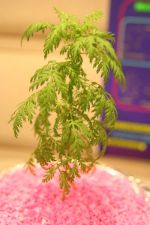Since the year 2002, NSTDA have been giving support to a research group from the Faculty of Pharmaceutical Sciences, Chulalongkorn University for the study project “The Bio-Synthesis of Bio-Active Compounds for the Development of Personnel and Bio-Technological Knowledge on Natural Products in Thailand”. The project
has developed an easier procedure to testing Qing Hao or Sweet Annie plant for artemisinin compound. The substance and its ions are the only group of substances that have resistance to malarial parasites and this is rarely found, bringing a lot of hope to researchers and millions of malaria patients all over the world.

There are a number of obstacles to Qing Hao genetic development. The determination of the means of bedding and harvesting are two constituent factors, while great difficulties lies in the analysis of the quantity of artemisinin in a Qing Hao plant. The conventional way of finding out is to use an HPLC or High Performance Liquid Chromatography machine. The procedure is expensive and requires experienced specialists to handle the analysis which takes a lot of time to analyze a single plant sample.
The research team has developed a new analytical procedure using Thin Layer Chromatography (TLC) together with a densitometer to scan a portion of the substance. The technique allows researchers to analyze tens of Qing Hao leaf samples at a time and it requires no high-experienced specialists. Additionally, researchers can also determine the amount of artemisinin compound in a plant by comparing the light intensity of TLC in a digital photo taken under black light with the standard graph. Furthermore, this type of analysis is beneficial to the tracking of the amount of artemisinin compound in Qing Hao plants to determine the most appropriate breed, cultivation area and harvest time.
